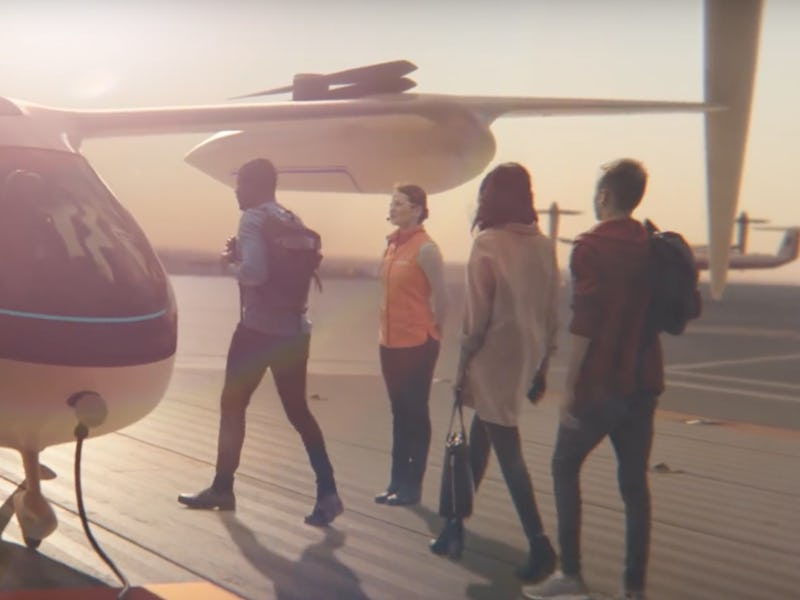Uber Wants Flying Taxis by 2020, and Here's Everything it Has to Do
Uber has a big plan in mind.

Uber laid out an ambitious plan on Wednesday to send passengers soaring through the skies. Uber Elevate, the official name for the flying taxi project, plans to send UberAir vertical takeoff and landing (VTOL) aircraft through the cities of Los Angeles, Dubai and Dallas-Fort Worth as soon as 2020. It’s a momentous task, so the company is employing the expertise of NASA to bring it to life.
The project has come a long way since Uber first released its flying car rideshare white paper in October last year. It all sounded exciting, but a lot of questions lingered about how the company could bring its idea to life. Uber’s new plan shows how the company will move forward from here, and everything it needs to do to make it happen.
“We are not boiling the ocean and trying to change all the airspace technology at the same time,” Uber chief product officer Jeff Holden told Bloomberg in an interview at Lisbon’s Web Summit on Wednesday.
Uber has signed a Space Act Agreement with NASA to develop the air traffic control systems. The agency is developing the basic framework, and Uber is joining in at a later stage, with the team initially testing low-flying helicopters around Dallas-Fort Worth airport. The eventual aircraft will communicate using Uber’s technology.
“It’s a perfect gathering of forces and skills to make this happen as fast as possible,” Holden said. It’s the first alliance of many, and Uber plans to announce partnerships with manufacturers further down the line.
If it succeeds, it could allow Uber to offer far cheaper and faster journeys than before. The original white paper describes a system that would allow travel from San Francisco’s Marina to downtown San Jose in just 15 minutes, a journey that normally takes two hours by car. Where that trip normally costs $111 in an UberX, initial VTOL prices would come in at $129 and drop down to $20 in the long term.
Uber's VTOL plan.
But air traffic control could be the least of Uber’s worries. Today’s lithium-ion batteries, packed up into an aircraft, could fly a subset of missions to a maximum of around 25 miles. The company wants to support missions up to 60 miles, which means battery advancements are needed.
Uber will need to improve both the underlying technology to store more power at lower weights, while also working out how to produce such systems on a mass scale. That’s no small feat: Tesla, a major electric car maker, has poured millions of dollars into building a factory in the Nevada desert, just to build batteries at fast enough speed to bring prices down. Thanks to its own research, Tesla has produced batteries that could last 20 years. Competitors like CATL and Northvolt are also building large-scale factories to churn out high-quality batteries for electric vehicles.
Flying cars are an area of intense research, and Uber is not the only player in town. Goole co-founder Larry Page revealed his Kitty Hawk flying car startup back in April, while established names like Airbus have been working on their own projects. Airbus’ A3 Vahana project was used as an example of a suitable aircraft in Uber’s white paper. If it strikes the right partnerships, Uber could leverage this research to its advantage.
Regulation is another hurdle the company faces, and one that it’s struggled with in the past. In March, it was revealed that Uber was using a special tool to stop enforcement officers from hailing rides through the app. In September, Transport for London denied Uber’s license renewal, claiming it was “not fit and proper”.
Uber has faced issues from regulators.
Holden claims Uber has “grown up as a company,” though, and Elevate won’t face the same issues as the past. Uber is aiming to launch in cities with enthusiastic local government approval, and it’s keen to work with cities to ensure it doesn’t fall afoul of rules.
“The regulators are embracing this,” Holden said. “I think it’s the excitement of the vision that gets everyone rallied around it.”
Los Angeles, a newly-announced location for the Elevate project, is a “model city” due to its high traffic congestion and need for a solution, Holden told the L.A. Times. Uber’s plan means that locals will make “heavy use” of UberAir by the 2028 Olympics.
But even with enthusiastic cities and advancements in battery technology, Uber needs to convince its customers to get inside a flying machine hurdling through the air at nearly 200 miles per hour. In the future, the company plans to transition to autonomous flying machines, another potential worry. It’s an issue Tesla CEO Elon Musk has criticized in the past.
“You’re thinking, ‘did they service their hubcap? Or is it going to come off and guillotine me as they’re flying past?’” Musk said at the TED 2017 conference in Vancouver in April.
The big question remains whether Uber can cope with the demands of scaling up a service while maintaining a suitable level of safety.
“We’ve studied this carefully and we believe it is scalable,” Holden told The Verge. “We’ve done the hard work so we can build skyports, and can get the throughput operationally to move tens of thousands flights per day per city.”
Uber has three years to prove the skeptics wrong.
Watch UberAir in action below: